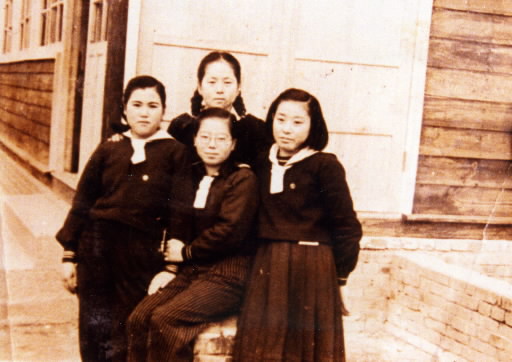Hiroshima Girls, Part 1: Life in Canada [2]
Jul. 3, 2010
Scars from atomic bombing stir anger and depression
by Masami Nishimoto, Staff Writer
This feature series on the "Hiroshima Girls," also known as "Hiroshima Maidens," is a close look at a number of Japanese women who were impacted by the atomic bombing of Hiroshima. The series was originally published in 1996.
"When I was young, I thought I would have been much happier if I had died at the time." Misako Tachibana, 66, began telling me about her life from the day of the atomic blast to the day she decided to journey to the United States for reconstructive plastic surgery.
At the time of the bombing, Ms. Tachibana was 15 years old and a second-year student at Hiroshima Girls' Commercial School. Her home was located in the area of Yano, part of today's Aki Ward. She was the youngest of three sisters. When she was in the 6th grade of elementary school, she contracted tuberculosis and so her enrollment at the Girls' Commercial School was delayed for a year. However, as the state of the war worsened for Japan, students began to be mobilized for the war effort as student "volunteers."
She left the house that day in a dark jacket that her mother had remade from a silk kimono and a pair of workpants. With a straw hat on her head and a cloth bag containing her lunch of roasted soybeans draped over her shoulder, she headed for the Tsurumi Bridge, located 1.6 kilometers from the hypocenter. It was the first day she would take part in work to dismantle houses to create a fire lane.
"Look, it's a 'Dear B,'" said one girl. Girls in wartime sarcastically tagged American B-29 bombers with this pet name. Ms. Tachibana turned her eyes toward the bomber, flying through the clear summer sky. But she could never have guessed that the plane was the Enola Gay and it was dropping an atomic bomb.
When she came to after the blast, she found she had been blown to the bank of the nearby river. Her jacket and her workpants were burned and dangling in strips like sea weed; only her underpants remained. She heard one of her classmates calling for her mother. Then she hurried east, taking small steps, running on and on.
"Misako?" Her mother broke down when she found her, so miserably altered, at a school in their neighborhood. After Ms. Tachibana was carried home on the panel of a wooden door from the school, she still hovered between life and death.
Her parents and sisters cleaned her wounds of pus, using gauze with saline water and ointment, or powder ground from bones collected at cremation sites. They made strenuous efforts to care for her.
According to the school's bound historical record, Hiroshima Girls' Commercial School lost 329 lives to the atomic bombing. The majority were first- and second-year students who were around the west end of the Tsurumi Bridge in Tsurumi-cho, now part of Naka Ward.
It was not until the following year that Ms. Tachibana returned to school, which had opened in a makeshift school building with sheets of tin for the roof. She hid her left cheek, scarred by the bomb, with a handkerchief in summer and a surgical mask in winter. At school, she concealed her claw-like left hand by wrapping it in a bandage, which she washed each day.
"It's an age when girls are troubled by even one pimple," she said. "Still, I had a good time at school because I had good friends. But after I finished school, it was like 'war' to me."
During the day she would confine herself at home; after dark she went out and stared at the sea alone. She tried new religions, one after another. Seeing young women of her age on the street, she felt depressed, thinking, "Why was I the only one to suffer this fate?"
Her mother pressed her to leave the house, but each time she did so, Ms. Tachibana's anger boiled over and she took out her rage on her mother, even throwing things at her. "I would take your place if I could!" her mother would say, in tears.
Eventually, she took up a job making Japanese-style wigs from her home in Yano, a thriving site for production of such wigs. Then, Yano's deputy mayor helped her land a job at the Yano branch office of the Hiroshima Prefectural Board of Education. However, any glimpse of her scars would continue to goad her to curse her fate.
"I was so timid," Ms. Tachibana recalled. "I lived virtually in seclusion."
Nine years after the atomic bombing, she was operated on four times by Dr. Tomin Harada, now 84, who escorted the "Hiroshima Girls" to the United States for plastic surgery the following year. The operations performed by Dr. Harada led to her joining the group of young women going to the United States, which included 11 of her schoolmates who had also survived the atomic bombing near the Tsurumi Bridge.
(Originally published on June 18, 1996)








